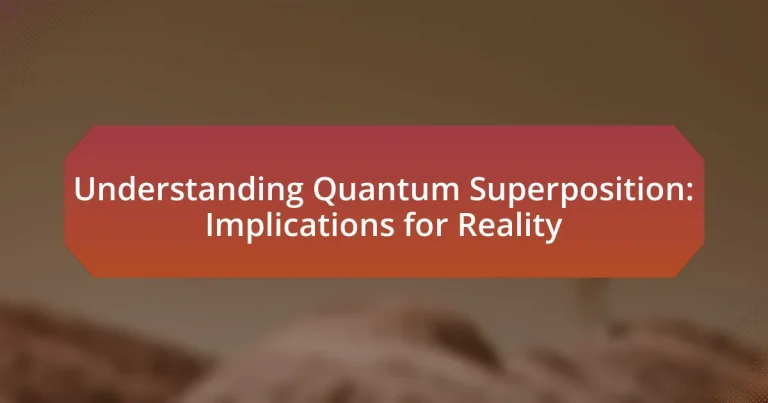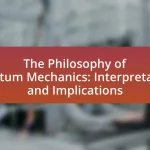Quantum superposition is a fundamental principle of quantum mechanics that allows a quantum system to exist in multiple states simultaneously until measured. This article explores the differences between quantum superposition and classical physics, its implications for reality, and its significance in quantum computing and entanglement. Key concepts such as wave-particle duality, the role of observation, and the philosophical questions arising from superposition are examined. Additionally, practical applications and future developments stemming from quantum superposition are discussed, highlighting its impact on technology and our understanding of the universe.

What is Quantum Superposition?
Quantum superposition is a fundamental principle of quantum mechanics that states a quantum system can exist in multiple states simultaneously until it is measured. This phenomenon allows particles, such as electrons, to occupy different positions or states at the same time, leading to the conclusion that the act of measurement collapses these multiple possibilities into a single outcome. The concept is exemplified by the famous thought experiment known as Schrödinger’s cat, which illustrates how a cat in a box can be simultaneously alive and dead until observed, highlighting the counterintuitive nature of quantum mechanics.
How does Quantum Superposition differ from classical physics?
Quantum superposition fundamentally differs from classical physics by allowing particles to exist in multiple states simultaneously until measured, whereas classical physics dictates that objects occupy a single, definite state at any given time. In quantum mechanics, for example, an electron can be in a superposition of spin-up and spin-down states, represented mathematically by a wave function, until an observation collapses this superposition into one of the possible states. This principle is evidenced by experiments such as the double-slit experiment, where particles display wave-like behavior and create interference patterns, indicating superposition, unlike classical particles that would produce distinct patterns.
What are the fundamental principles of Quantum Superposition?
The fundamental principles of Quantum Superposition state that a quantum system can exist in multiple states simultaneously until it is measured. This principle is exemplified by Schrödinger’s cat thought experiment, where a cat in a box is both alive and dead until observed. Quantum mechanics, as formalized in the mathematical framework of wave functions, describes this phenomenon, where the superposition of states leads to a probability distribution of outcomes. The principle is validated by experiments such as the double-slit experiment, which demonstrates that particles like electrons exhibit wave-like behavior, creating interference patterns indicative of superposition.
How does Quantum Superposition relate to wave-particle duality?
Quantum superposition is a fundamental principle in quantum mechanics that describes a system’s ability to exist in multiple states simultaneously until measured. This principle directly relates to wave-particle duality, which posits that particles, such as electrons and photons, exhibit both wave-like and particle-like properties depending on the experimental context.
In experiments like the double-slit experiment, particles demonstrate interference patterns characteristic of waves when not observed, indicating superposition. However, when measured, they appear as discrete particles, collapsing into a single state. This behavior exemplifies how quantum superposition underlies the wave-particle duality, as the system’s state is not determined until observation occurs, reflecting the dual nature of quantum entities.
Why is Quantum Superposition important in quantum mechanics?
Quantum superposition is important in quantum mechanics because it allows particles to exist in multiple states simultaneously, fundamentally altering our understanding of reality. This principle underlies phenomena such as interference patterns in experiments like the double-slit experiment, where particles like electrons display wave-like behavior, suggesting they occupy multiple paths at once until measured. The mathematical framework of quantum mechanics, particularly the wave function, encapsulates this superposition, enabling predictions about the behavior of quantum systems. This concept is crucial for technologies such as quantum computing, where superposition allows for the processing of vast amounts of information simultaneously, demonstrating its significance in both theoretical and practical applications.
What role does Quantum Superposition play in quantum computing?
Quantum superposition is fundamental to quantum computing as it allows quantum bits, or qubits, to exist in multiple states simultaneously, enabling parallel processing of information. This property significantly enhances computational power, allowing quantum computers to solve complex problems more efficiently than classical computers. For instance, while a classical bit can be either 0 or 1, a qubit can be in a state representing both 0 and 1 at the same time, which exponentially increases the amount of information that can be processed. This principle is crucial for algorithms like Shor’s algorithm for factoring large numbers, demonstrating the practical implications of quantum superposition in achieving computational advantages.
How does Quantum Superposition influence quantum entanglement?
Quantum superposition influences quantum entanglement by allowing particles to exist in multiple states simultaneously, which creates the conditions necessary for entangled states. When two particles are in a superposition, their states become interdependent, leading to correlations that define entanglement. For instance, if one particle is measured and collapses into a definite state, the other particle, regardless of distance, instantaneously assumes a corresponding state due to their entangled nature. This phenomenon is supported by experiments such as the Bell test experiments, which demonstrate that entangled particles exhibit correlations that cannot be explained by classical physics, confirming the role of superposition in establishing entanglement.

What are the implications of Quantum Superposition for our understanding of reality?
Quantum superposition implies that particles can exist in multiple states simultaneously, fundamentally challenging classical notions of reality. This phenomenon suggests that reality is not deterministic; rather, it is probabilistic, as demonstrated by experiments like the double-slit experiment, where particles behave as both waves and particles depending on observation. The implications extend to the nature of consciousness and measurement, indicating that the act of observation collapses superpositions into a single outcome, thus influencing our understanding of the observer’s role in defining reality.
How does Quantum Superposition challenge classical notions of reality?
Quantum superposition challenges classical notions of reality by allowing particles to exist in multiple states simultaneously until measured. In classical physics, objects have definite properties and states, but quantum superposition reveals that particles like electrons can be in a combination of states, such as being in two places at once. This phenomenon is exemplified by the double-slit experiment, where particles display wave-like behavior, creating interference patterns that suggest they pass through both slits simultaneously. This contradicts classical determinism and suggests that reality at the quantum level is fundamentally probabilistic, leading to debates about the nature of observation and measurement in defining reality.
What philosophical questions arise from Quantum Superposition?
Quantum superposition raises several philosophical questions regarding the nature of reality, observation, and determinism. One significant question is whether reality exists independently of observation, as superposition suggests that particles can exist in multiple states until measured. This leads to inquiries about the role of the observer in defining reality and whether consciousness influences physical processes. Additionally, the implications of superposition challenge classical notions of determinism, prompting questions about free will and the nature of causality. These philosophical dilemmas highlight the complexities of interpreting quantum mechanics and its impact on our understanding of existence.
How does Quantum Superposition affect our perception of determinism?
Quantum superposition challenges our perception of determinism by introducing the concept that particles can exist in multiple states simultaneously until measured. This phenomenon implies that outcomes are not predetermined but rather probabilistic, as demonstrated in experiments like the double-slit experiment, where particles behave as both waves and particles depending on observation. The implications of quantum superposition suggest that reality is not strictly deterministic, as classical physics would imply, but instead is influenced by the act of measurement, leading to a fundamental shift in how we understand causality and predictability in the universe.
What are the practical applications of Quantum Superposition?
Quantum superposition has practical applications in quantum computing, quantum cryptography, and quantum sensing. In quantum computing, superposition allows qubits to exist in multiple states simultaneously, enabling faster processing and complex problem-solving capabilities compared to classical bits. For instance, Google’s quantum computer Sycamore demonstrated this by performing a specific computation in 200 seconds that would take classical supercomputers thousands of years. In quantum cryptography, superposition is utilized in protocols like Quantum Key Distribution (QKD), which ensures secure communication by leveraging the principles of quantum mechanics to detect eavesdropping. Lastly, quantum sensing employs superposition to enhance measurement precision, as seen in atomic clocks that utilize superposition states to achieve unprecedented accuracy, improving GPS technology and timekeeping.
How is Quantum Superposition utilized in modern technology?
Quantum superposition is utilized in modern technology primarily through quantum computing, where qubits can exist in multiple states simultaneously, enabling complex calculations at unprecedented speeds. This principle allows quantum computers to solve problems that are intractable for classical computers, such as factoring large numbers and simulating quantum systems. For instance, Google’s Sycamore processor demonstrated quantum supremacy by performing a specific computation in 200 seconds that would take the most powerful supercomputers thousands of years to complete. Additionally, quantum superposition is foundational in quantum cryptography, enhancing security through protocols like Quantum Key Distribution, which ensures that any eavesdropping attempts can be detected due to the nature of superposition.
What are the potential future developments stemming from Quantum Superposition?
Potential future developments stemming from Quantum Superposition include advancements in quantum computing, enhanced quantum cryptography, and breakthroughs in quantum communication. Quantum computing leverages superposition to perform complex calculations at unprecedented speeds, potentially revolutionizing industries such as pharmaceuticals and materials science. Enhanced quantum cryptography utilizes superposition to create secure communication channels that are theoretically immune to eavesdropping, as demonstrated by protocols like Quantum Key Distribution (QKD). Additionally, breakthroughs in quantum communication could lead to the development of a quantum internet, enabling instantaneous data transfer across vast distances. These developments are supported by ongoing research, such as the work by Google and IBM in quantum processors, which showcases the practical applications of superposition in real-world scenarios.

How can we further explore Quantum Superposition?
To further explore Quantum Superposition, researchers can conduct experiments that utilize advanced quantum computing systems to manipulate and observe superposition states. For instance, experiments involving qubits in quantum computers allow scientists to test the principles of superposition in practical applications, such as quantum algorithms and cryptography. A notable example is the work by IBM and Google, which has demonstrated quantum supremacy through the manipulation of qubits, showcasing the potential of superposition in solving complex problems faster than classical computers. This empirical evidence supports the exploration of superposition’s implications for reality, as it challenges classical notions of determinism and introduces new paradigms in information processing.
What resources are available for learning about Quantum Superposition?
Books, online courses, and academic papers are key resources for learning about Quantum Superposition. Notable books include “Quantum Mechanics: The Theoretical Minimum” by Leonard Susskind and Art Friedman, which provides foundational knowledge. Online platforms like Coursera and edX offer courses from institutions such as MIT and Stanford, covering quantum mechanics and superposition concepts. Academic papers, such as “Quantum Superposition and the Measurement Problem” by J. S. Bell, provide in-depth analysis and research findings. These resources collectively enhance understanding of Quantum Superposition and its implications in quantum physics.
Which books and articles provide in-depth insights into Quantum Superposition?
Books and articles that provide in-depth insights into Quantum Superposition include “Quantum Mechanics: The Theoretical Minimum” by Leonard Susskind and Art Friedman, which offers a foundational understanding of quantum principles, including superposition. Another significant work is “Quantum Physics for Beginners” by Carl J. Pratt, which explains the concept in an accessible manner. Additionally, the article “Quantum Superposition: A Review” by A. M. K. M. Al-Azab, published in the Journal of Physics, delves into the theoretical aspects and implications of superposition in quantum mechanics. These sources collectively enhance the understanding of Quantum Superposition and its relevance in the broader context of quantum theory.
What online courses or lectures can enhance understanding of Quantum Superposition?
Online courses that enhance understanding of Quantum Superposition include “Quantum Mechanics for Beginners” on Coursera, which covers foundational concepts including superposition, and “Quantum Physics: A Beginner’s Guide” on Udemy, focusing on the principles of quantum mechanics. Additionally, MIT OpenCourseWare offers “Quantum Physics I,” providing in-depth lectures and materials on superposition and its implications. These courses are designed to provide a structured learning path and include resources that reinforce the concepts of quantum superposition through practical examples and theoretical discussions.
What are some common misconceptions about Quantum Superposition?
Common misconceptions about quantum superposition include the belief that particles exist in multiple states simultaneously in a classical sense, and that superposition implies randomness rather than a defined probability distribution. Quantum superposition means that a quantum system can exist in multiple states at once, but these states are not classical states; they are described by a wave function that provides probabilities for each possible outcome. This concept is supported by experiments such as the double-slit experiment, which demonstrates that particles like electrons can exhibit wave-like behavior, leading to interference patterns that can only be explained through superposition. Additionally, some people mistakenly think that observation collapses a superposition into a single state, when in fact, the act of measurement reveals the state that was probabilistically determined by the wave function prior to observation.
How can we clarify the misunderstandings surrounding Quantum Superposition?
To clarify the misunderstandings surrounding Quantum Superposition, it is essential to explain that Quantum Superposition refers to a fundamental principle in quantum mechanics where a quantum system can exist in multiple states simultaneously until it is measured. This concept can be illustrated through the famous double-slit experiment, which demonstrates that particles like electrons can exhibit both wave-like and particle-like behavior, depending on whether they are observed.
Misunderstandings often arise from the interpretation of superposition as implying that particles exist in all states at once in a classical sense, rather than in a probabilistic framework defined by quantum mechanics. The Copenhagen interpretation, one of the most widely accepted interpretations, posits that the act of measurement collapses the superposition into one of the possible states, thus clarifying that superposition is not about simultaneous existence in a classical manner but rather about potential outcomes that are realized upon observation.
By emphasizing these key aspects and providing clear examples, such as the double-slit experiment, we can effectively address and clarify the common misconceptions about Quantum Superposition.
What are the most frequently asked questions about Quantum Superposition?
The most frequently asked questions about Quantum Superposition include: “What is quantum superposition?”, “How does quantum superposition work?”, “What are the implications of quantum superposition for reality?”, “Can quantum superposition be observed?”, and “What is the role of quantum superposition in quantum computing?”. These questions reflect a fundamental curiosity about the nature of quantum mechanics and its effects on our understanding of the universe. Quantum superposition describes a system’s ability to exist in multiple states simultaneously until measured, as demonstrated in experiments like the double-slit experiment, which illustrates the wave-particle duality of light and matter.
What practical tips can help in understanding Quantum Superposition?
To understand Quantum Superposition, visualize it through the analogy of a spinning coin, which represents multiple states existing simultaneously until observed. This analogy illustrates how particles can exist in multiple states at once, similar to how a coin is both heads and tails while in motion. Additionally, engaging with interactive simulations or educational software that demonstrates superposition can enhance comprehension by providing visual and practical examples of how particles behave in quantum mechanics. Research by physicists, such as those published in “Quantum Mechanics: Concepts and Applications” by Nouredine Zettili, supports these methods by showing that visual aids and analogies significantly improve understanding of complex quantum concepts.




